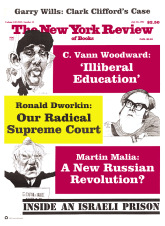To the Editors:
When we were in Moscow in late May attending the First Andrei Sakharov Memorial Congress on Human Rights, we heard continuing reports of deportations of thousands of ethnic Armenian villagers from their villages in Azerbaijan and Nagorno-Karabakh, and received permission from President Gorbachev to go there to examine the situation.
Under the leadership of Lady Caroline Cox, a deputy speaker of the British House of Lords, and with twelve other Congress participants, we spent five days in the border villages of Armenia and Azerbaijan, interviewing several hundred eyewitnesses, including refugees, Armenian and Azeri militiamen, and officers of the KGB and Soviet Army. We also talked with President Levon Ter-Petrosian of Armenia in Yerevan, President Ayaz Mutalibov of Azerbaijan in Baku, Chairman of the USSR Supreme Soviet Anatoly I. Lukyanov, and USSR Defense Minister Dmitri Yazov, in Moscow.
Our investigation revealed that the violence was not merely a continuation of the ethnic rivalry between Christian Armenians and Muslim Azerbaijanis that has plagued the area for centuries, most intensely since 1988. We found a new element: the Soviet Fourth Army stationed in Azerbaijan, and Soviet internal troops of the Interior Ministry, were engaged in a joint effort with special units (“OMON”) of the Azerbaijani Ministry of Internal Affairs, to forcibly deport Armenian civilians from Azerbaijani-controlled territory along the border.
It is still unclear just why Soviet forces acted so brutally. But many of our official sources, including not only Armenians but Soviet army officers and Azerbaijani OMON, acknowledged that Armenia’s strong independence movement, and refusal to agree to the “nine plus one” agreement on the new union treaty, was related to the ferocity and timing of the recent campaign against the Armenians.
From our interviews with refugees and Soviet Army officers, we estimate that as of the third week of May about 7,000 Armenians had been deported from the area, and these deportations are continuing. We believe that at least fifty ethnic Armenians have been killed—eighteen in Getashen, outside the disputed Nagorno-Karabakh area in Azerbaijan, fifteen in Voskepar in northeast Armenia, and elsewhere. Reportedly, 100 to 200 have “disappeared,” after being taken into custody. We also heard and were able to verify detailed reports of torture, assault, and organized looting.
Virtually all of the more than 200 refugees we talked to described experiences that had a strikingly similar pattern: after surrounding the villages with tanks and personnel, up to a half dozen Soviet helicopter gunships were sent to “buzz” the villages. The Soviet troops then entered the villages under the pretext of checking passports and obtaining illegal weapons from the residents. The Soviet soldiers then surrendered many of the village men to the Azerbaijani internal troops and OMON. We heard convincing reports that these captives were subjected to physical and psychological abuse and were then imprisoned without charge in inhuman conditions, often without food, water, or sanitary facilities, for from two days to a week.
On the Armenian border, as in the Baltics in January 1991, units of the local police (“militsia”) were a special target. The most bloody single incident appears to have occurred at Voskepar, on Armenia’s north-eastern border, when eleven Armenian militia officers were ambushed and killed while traveling in a minibus on the way to guard the villagers. A Russian lieutenant of the Fourth Army acknowledged serious misconduct by Soviet forces. He complained that his recruits were more then 50 percent Azerbaijani, were highly partisan, and difficult to control. Our meetings later in Moscow with Defense Minister Yazov and Supreme Soviet Chairman Lukyanov made it clear that at the highest level the Soviet leadership was aware of these events.
Western governments whose protests against Soviet killings in the Baltic republics stopped Kremlin troops from further violence, have so far turned a blind eye to these acts of force against Armenians. The risks of inattention are many: radical Armenian forces are already pressing Ter-Petrosian’s government to take military action, and many are calling for a new government. The fall of Ter-Petrosian’s forward-thinking government could lead to still greater violence and suffering.
The Armenian government has appealed to the UN for observers and peacekeeping forces and most observers we met also look to the UN for help. Other international human rights groups and officials of the International Committee of the Red Cross should be invited to investigate conditions inside the depopulated Armenian Villages, and in the prisons. To the cries of the women and children who asked us “What will we do now?” we hope the world community will respond by pressing Gorbachev to stop further deportations from this “internal Afghanistan.”
Felice D. Gaer
Executive Director of the International
League for Human Rights
Scott Horton
Sakharov Congress on Human Rights
New York City
This Issue
July 18, 1991



